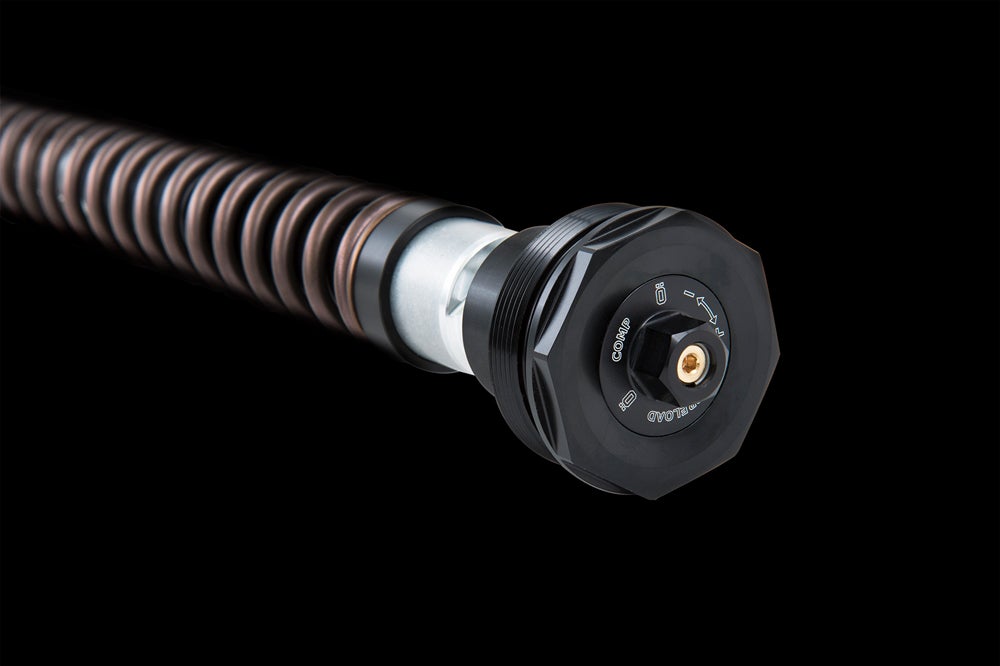NIX TECHNOLOGY

We channel the knowledge our engineers accumulate on a daily basis when working with the world's top riders into an improved design so that you easily can have it properly maintained and every kit is individually tested with an optimum setting, spring and top-out spring.
HOW DOES IT WORK?
The front fork cartridge kit is divided into one compression cartridge and one rebound cartridge. The compression cartridge is installed in the left front fork leg and the rebound cartridge in the right front fork leg. Marked at the top cap is 'COMP' for compression adjustment and 'REB' for rebound adjustment.
The compression and rebound cartridges are both based on the same design, but work opposite one another. To achieve rebound damping force instead of compression damping force, the cylinder tubes and the pistons are turned opposite of each other between the compression and the rebound cartridges. When the front fork moves, the fluid inside is forced to flow through the pistons.
During compression movement, the fluid is forced through the compression shim stack and rebound check valve simultaneously, while fluid is forced through the rebound shim stack and compression check valve during rebound movement. The fluid displaced by the piston shafts is directed either into or out of the cylinder tubes through the holes (Fig. 2).
The compression and the rebound pistons are both of the same design. The pistons have three flow paths for the fluid:
- Bleed valve (Fig. 3, center gray arrows): Small orifice that creates a flow restriction simply by being small.
- Shim valve (Fig. 3, outer black arrows): Fluid pressure has to deflect thin steel washers (shims) to open up an orifice and allow fluid to flow through it.
- Check valve (Fig. 3, outer white arrows): A spring-preloaded shim that opens easily, for return flow of fluid when the direction of movement of the front fork changes. The bleed valve and shim valve are used to build up damping force. At slow stroke speeds, the percentage going through the bleed valve is higher, while at fast stroke speeds, the shim valve takes care of most of the flow. Since it can flow in both directions, the check valve works in conjunction with the bleed valve to handle return flows.
To control the damping forces, the bleed valve can be changed through the external compression and rebound adjuster. By altering the stiffness of the shim stackquantity, thickness, diameter, and shape—on the shim valve, the characteristics of the damping action can be changed.
COMPRESSION DAMPING
COMPRESSION FRONT FORK LEG
When movement of the motorcycle causes compression of the front fork (Fig. 4
compression movement), the fluid below the compression piston is pressurized and goes through:
- Compression shim valve
- Compression bleed valve
REBOUND FRONT FORK LEG
When movement of the motorcycle causes compression of the front fork (Fig. 4, compression movement), the fluid below the rebound piston is pressurized and goes through:
- Rebound check valve
- Rebound bleed valve (small and insignificant flow, compared to check valve)
DISPLACED FLUID
During compression movement, the piston shafts enter the cylinder tubes and the correspondingly displaced volume of fluid has to flow out of the cylinder tubes through the holes.
REBOUND DAMPING
REBOUND FRONT FORK LEG
When the spring forces the front fork to extend again (Fig. 5 rebound movement), the fluid above the rebound piston is pressurized and in a similar pattern as compression movement, goes through:
- Rebound shim valve
- Rebound bleed valve
COMPRESSION FRONT FORK LEG
Similar to the rebound front fork leg at a compression movement, the pressure difference between above and below the compression piston causes the fluid to go through:
- Compression check valve
- Compression bleed valve (small and insignificant flow compared to the check valve)
DISPLACED FLUID
The fluid that was displaced by the piston shafts is now pushed back into the cylinder tubes by the pressure difference between the outside and inside of the cylinder tubes.
BENEFITS OF NIX

Easy to install, change springs, change shim settings, service, etc

Fully individual compression and rebound adjusters

Damping dynamics and response stays constant over full adjustment range

All adjustments (preload, compression and rebound adjustment) are made at the top of the fork legs
